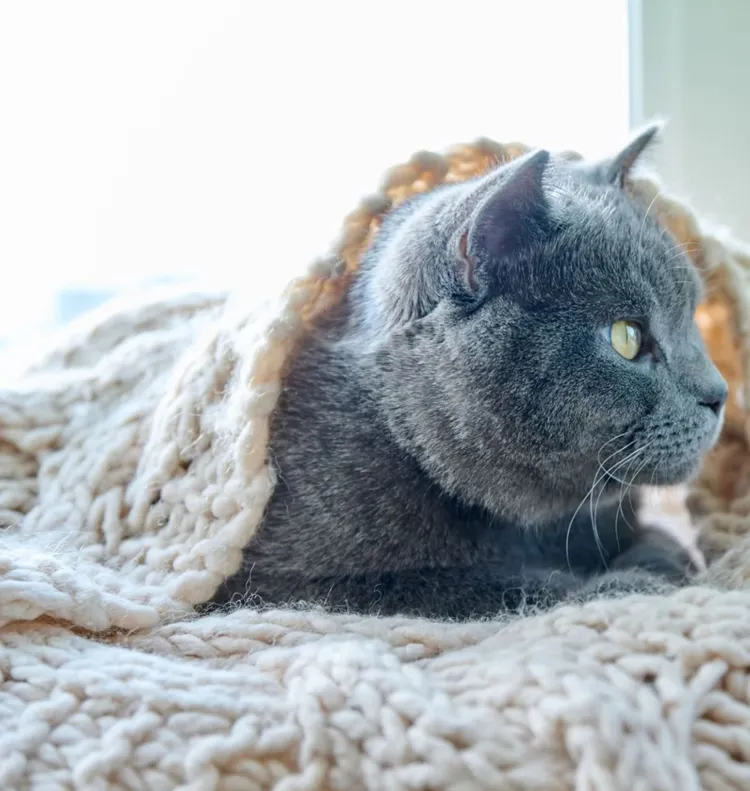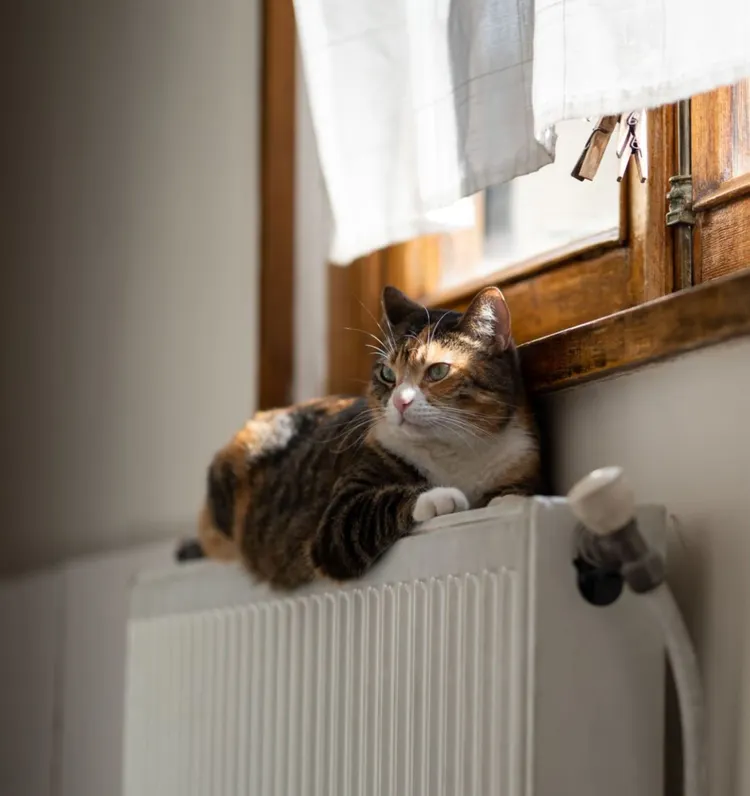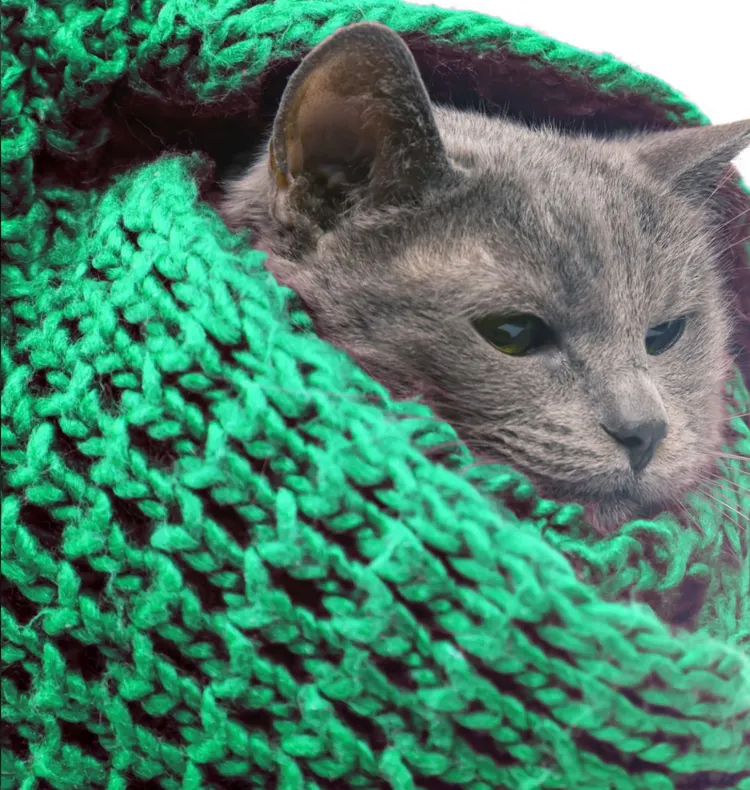Ever noticed your cat curling up in the tiniest sunbeam or snuggling deeper into blankets when the temperature drops? Cats may be independent creatures, but when it comes to cold weather, even they need a little extra warmth. Understanding how cats respond to cooler temperatures and how to keep them comfortable can make a big difference in their health and happiness, especially during the colder months. This guide will help you identify signs that your cat might be cold and provide eco-friendly tips to keep them cozy and warm all winter long.
How Do Cats Handle Cold Weather?
While some cats are well-equipped to handle the cold thanks to thick fur coats, many, particularly short-haired, elderly, or sick cats, may struggle in colder temperatures. Cats are naturally desert animals, which means they tend to prefer warmth over cold. Their body temperature hovers between 100.5°F and 102.5°F, and when the ambient temperature drops below 45°F, they can start feeling chilly.
Short-Haired and Older Cats
Short-haired cats or hairless breeds, such as the Sphynx, have a harder time retaining body heat. Similarly, older cats, those with arthritis, or cats with underlying health issues may struggle even more to maintain their body temperature in cooler environments. If your home gets particularly cold in the winter, extra care is essential for these more vulnerable cats.
Natural Cold Adaptations in Cats
Some cats have adapted to colder climates. For instance, breeds like the Maine Coon or Norwegian Forest Cat have thick, water-resistant coats that help them insulate against the cold. However, even these hearty breeds can benefit from a little extra warmth, especially if they live indoors or spend limited time outside.
Signs Your Cat Is Feeling Cold
Cats are experts at hiding discomfort, but there are several telltale signs that may indicate your cat is feeling cold:
1. Curling Up Tightly
While cats often curl up to sleep, doing so more frequently or in particularly tight positions may signal they’re trying to conserve body heat. If they burrow under blankets or into cushions, it’s a good indicator they’re trying to stay warm.
2. Cold Ears, Nose, or Paws
Gently touch your cat’s ears, nose, or paws. If they feel cold to the touch, it’s a sign that your cat’s body is losing heat.
3. Seeking Heat Sources
A cat that regularly finds its way to the radiator, fireplace, or sunny window spot is likely trying to stay warm. If your cat is suddenly glued to warm spots around the house, they might be feeling the cold.
4. Shivering or Trembling
Though not as common, cats may tremble or shiver if they’re feeling very cold. If you notice this behavior, it’s time to take immediate steps to warm them up.
5. Decreased Activity or Lethargy
A cold cat may become less active or lethargic as they conserve energy. If your usually playful feline is suddenly lying still more often, it might be due to the temperature.

Eco-Friendly Ways to Keep Your Cat Warm
You don’t have to sacrifice your eco-friendly values to keep your cat cozy during the colder months. Here are some sustainable and environmentally conscious ways to ensure your furry friend stays warm:
1. Eco-Friendly Cat Blankets
One of the easiest ways to keep your cat warm is by providing soft, warm blankets. Choose options made from organic cotton, wool, or recycled materials. Wool is an excellent natural insulator, and organic cotton is a great hypoallergenic option for cats with sensitive skin. Brands specializing in sustainable pet products often offer high-quality, eco-friendly blankets that are both cozy and green.
2. Insulated Bedding
Investing in insulated pet beds made from recycled or sustainable materials can provide your cat with a warm, comfortable place to rest. Look for beds made from recycled fibers, like plastic bottles, or ones stuffed with natural, biodegradable materials like wool or kapok.
Alternatively, you can DIY an insulated bed using upcycled items you already have at home. Line a cardboard box with old sweaters or fabric scraps for a snug, environmentally friendly option. Adding a few layers of fabric between your cat and the cold floor can make a huge difference in maintaining warmth.
3. Natural Heat Sources
One of the best ways to keep your cat warm is to place their bed in a naturally warm spot. A sunny windowsill, near a radiator, or next to the stove (safely away from any fire hazards) are great locations. You can also try energy-efficient heating pads that use minimal electricity. Look for pads that automatically turn off after a set time or use eco-friendly gel technology to stay warm without electricity.
4. DIY Cat Sweaters
For hairless or short-haired cats, a sweater can provide much-needed warmth. Instead of buying mass-produced synthetic sweaters, try making a DIY sweater from upcycled fabrics. Old wool socks or sweaters that are no longer wearable for humans can be repurposed into a cozy, fitted sweater for your cat. This not only keeps your cat warm but also reduces waste and promotes sustainable living.
5. Sustainable Cat Heating Pads
If your cat needs extra warmth, consider using energy-efficient heating pads designed for pets. Some eco-friendly options use renewable energy sources or minimal electricity. You can also find heating pads that use sustainable materials and are designed to be durable and long-lasting, reducing waste over time.

Preventing Cold-Related Health Issues
Prolonged exposure to cold temperatures can lead to several health issues in cats, including hypothermia and arthritis flare-ups. Taking preventive measures is crucial, especially for cats that are already vulnerable due to age or illness.
Hypothermia
Cats can experience hypothermia if their body temperature drops too low, especially if they’re exposed to cold drafts or outdoor environments for long periods. Signs of hypothermia include extreme shivering, cold extremities, and lethargy. If you suspect your cat is hypothermic, move them to a warm environment immediately and consult your vet.
Arthritis
Cold weather can exacerbate joint pain in arthritic cats. Provide your senior cat with plenty of warm, soft spots to rest and consider using eco-friendly joint supplements or natural remedies to ease discomfort.
Outdoor Cats and Cold Weather
For those who care for outdoor or stray cats, ensuring they have a safe, warm place during colder months is critical. Here are some eco-conscious ways to provide warmth for outdoor cats:
1. Eco-Friendly Shelters
Create an insulated shelter using sustainable materials like wood, straw, and recycled items. Straw is a natural, eco-friendly insulator that helps trap body heat without absorbing moisture. Place the shelter in a dry, covered area, away from wind and rain, to keep it warm and dry. You can also build a shelter using repurposed items like old crates or coolers.
2. Outdoor Heating Pads
For extremely cold conditions, use outdoor heating pads that are energy-efficient or solar-powered. Ensure they are designed for outdoor use and are waterproof to protect your cat from the elements.
3. Keep Fresh Water Available
Even in cold weather, cats need access to fresh water. Heated water bowls can help prevent water from freezing and ensure that outdoor cats stay hydrated throughout the winter.
Conclusion
When the weather turns cold, your cat will likely appreciate a little extra warmth and comfort. By recognizing the signs that your cat is feeling chilly and providing eco-friendly solutions, you can help keep your feline friend cozy and safe throughout the colder months. Whether it’s through organic blankets, natural heat sources, or sustainable bedding, there are plenty of environmentally conscious ways to keep your cat warm without compromising your values.
With just a few thoughtful adjustments, you can ensure your cat is as snug as can be, no matter how low the temperature drops.



